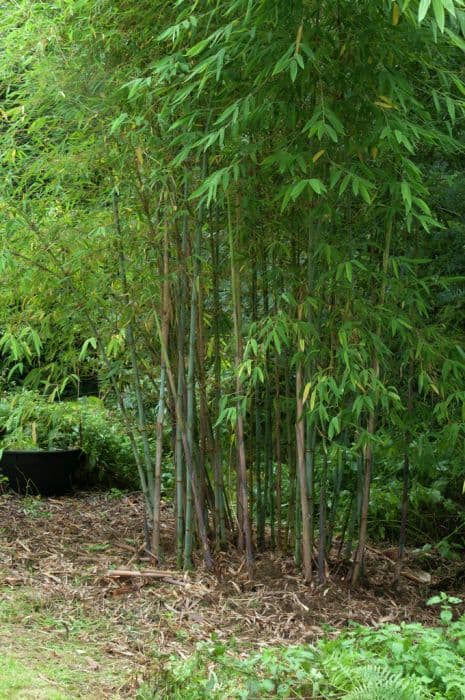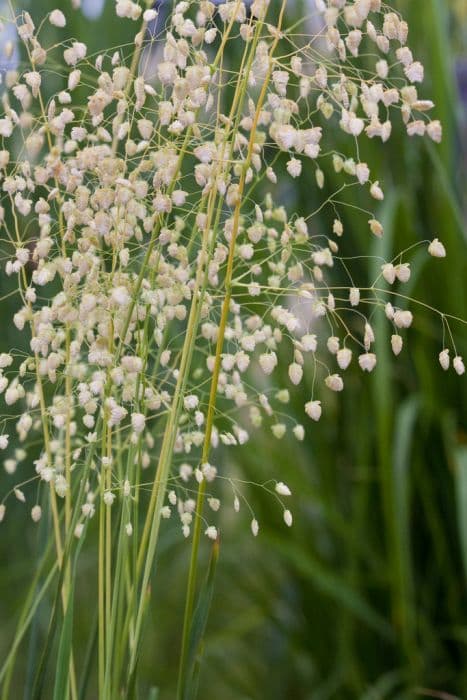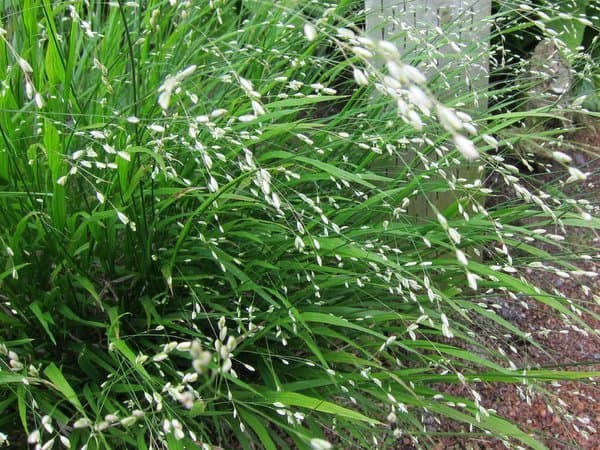Bearskin fescue Festuca gautieri

ABOUT
The plant commonly known as the bear skin fescue features a distinctive, dense, and cushion-like tufted habit, which contributes to its plush bear skin-like appearance. This evergreen perennial is characterized by fine-textured, needle-like leaves that are a vibrant green color, providing year-round visual interest. Its foliage has a bristle-like quality, forming tight mounds that can resemble small green pin cushions or mossy hillocks from a distance. The overall form of bear skin fescue is highly structured, creating an aesthetically pleasing, rounded shape that is both neat and compact. Despite a hardy nature, the plant exudes a soft texture, inviting touch. It generally presents a bright and fresh hue, enhancing its appeal in various garden settings.
About this plant
 Names
NamesFamily
Poaceae
Synonyms
Bearskin Fescue, Spiky Bearskin
Common names
Festuca scoparia, Festuca eskia subsp. gautieri, Festuca gautieri subsp. scoparia.
 Toxicity
ToxicityTo humans
Bearskin fescue is not widely known to be toxic to humans. Therefore, there are no specific symptoms of poisoning associated with this plant to describe. It's always advised to exercise caution and refrain from ingesting plants that are not commonly consumed as food, as individual sensitivities can vary.
To pets
Bearskin fescue is not considered to be toxic to pets. There are no well-documented cases of poisoning in domestic animals, such as cats and dogs, from this plant. As with humans, it is still generally recommended to prevent pets from ingesting non-food plants to avoid any potential sensitivities or gastrointestinal upset.
 Characteristics
CharacteristicsLife cycle
Perennials
Foliage type
Evergreen
Color of leaves
Green
Height
6 inches (15 cm)
Spread
12 inches (30 cm)
Plant type
Grass
Hardiness zones
4
Native area
Europe
Benefits
 General Benefits
General Benefits- Drought tolerance: Festuca gautieri, also known as Bearskin fescue, is highly resistant to drought, making it ideal for xeriscaping and low-water gardens.
- Low maintenance: Bearskin fescue requires minimal care once established, as it has low watering, fertilizing, and mowing needs.
- Erosion control: With its dense, mat-forming growth, Bearskin fescue can help prevent soil erosion on slopes and in other vulnerable areas.
- Tolerates poor soils: It can thrive in a wide range of soil types, including poor soils where other plants may struggle to survive.
- Ornamental appeal: Bearskin fescue has a unique, finely textured appearance with evergreen foliage, offering year-round visual interest in the landscape.
- Compact growth habit: Its small, mound-shaped form makes Bearskin fescue suitable for rock gardens, borders, and ground cover applications.
- Resists pests and diseases: It's generally resistant to common lawn pests and diseases, reducing the need for chemical treatments.
- Cold hardiness: Bearskin fescue is capable of withstanding cold temperatures, making it suitable for gardens in cooler climates.
- Fire resistance: As a low-growing and moisture-retentive plant once established, it can contribute to fire-resistant landscaping.
- Wildlife friendly: Though not specifically a benefit for all, it can provide a habitat for small wildlife and insects within a garden setting.
 Medical Properties
Medical PropertiesThis plant is not used for medical purposes.
 Air-purifying Qualities
Air-purifying QualitiesThis plant is not specifically known for air purifying qualities.
 Other Uses
Other Uses- Festuca gautieri, commonly known as bear skin fescue, can be used in miniature and fairy gardens for its fine-textured grass that resembles a tiny forest or meadow under scaled-down fairytale settings.
- Bear skin fescue clumps can serve as natural mulch between stepping stones on a garden path, providing a green cushioning that reduces weed growth while tolerating light foot traffic.
- This plant can be used in green roofing, where its drought tolerance and low maintenance make it suitable for creating sustainable, visually appealing living roof systems.
- When dried, the tufts of bear skin fescue can be used in floral arrangements, providing an interesting texture and a long-lasting natural green element that complements other dried flowers.
- It can be incorporated into pet habitats, such as for reptiles or small mammals, as part of a naturalistic enclosure that mimics their wild environment.
- Bear skin fescue serves as erosion control on slopes and banks, where its dense growth and root system help to hold the soil in place and prevent runoff.
- This plant can be used as a textured ground cover in model railway or architectural models to represent grassy areas with a realistic appearance at a small scale.
- Artists can use bear skin fescue as a natural brush or pen when dipped in ink or paint, exploiting the stiff nature of its blades to create unique textures on paper or canvas.
- It can be woven into small mats or coasters, with the strong, wiry leaves offering a rustic look and a durable surface that can handle hot dishes.
- Due to its resistance to cold and compact growth, bear skin fescue can be ideal for creating green outdoor living spaces in rooftop gardens or balconies in urban settings with limited space.
Interesting Facts
 Feng Shui
Feng ShuiBearskin fescue is not used in Feng Shui practice.
 Zodiac Sign Compitability
Zodiac Sign CompitabilityBearskin fescue is not used in astrology practice.
 Plant Symbolism
Plant Symbolism- Resilience: Festuca gautieri, commonly known as Bearskin fescue, often symbolizes resilience due to its tough, hardy nature and ability to thrive in poor soil conditions.
- Endurance: Reflecting its ability to withstand drought and low-water environments, Bearskin fescue can represent endurance and the capacity to persist through difficult times.
- Minimalism: With its compact, low-growing habit and fine texture, Bearskin fescue may be associated with simplicity and minimalism, making it a choice for gardens embodying these principles.
- Natural Beauty: Often used in naturalistic landscaping, Bearskin fescue represents an appreciation for the understated beauty found in nature and a move away from high-maintenance gardening styles.
 Water
WaterBearskin fescue requires moderate watering to maintain its health and appearance. It's best to water the plant deeply but infrequently, allowing the top inch of soil to dry out between waterings. Depending on the climate and the environment, this could mean providing approximately 1 gallon of water every week during the growing season. Reduce watering in the winter months when the plant is not actively growing. Avoid overwatering as this can lead to root rot.
 Light
LightBearskin fescue thrives in full sun to partial shade. It prefers to be placed in a spot where it can receive at least 6 hours of direct sunlight each day. Partial shade is acceptable, especially in hot climates, but too much shade may reduce the density of the plant's foliage.
 Temperature
TemperatureBearskin fescue is hardy and can tolerate a range of temperatures. It can survive in temperatures as low as -20 degrees Fahrenheit and as high as 80 degrees Fahrenheit, though it thrives best in cooler conditions. The ideal temperature range for this plant is between 60 and 70 degrees Fahrenheit.
 Pruning
PruningPrune Bearskin fescue to remove dead or damaged foliage and to maintain its shape. This is best done in the early spring before new growth starts. Trimming once a year is usually sufficient to keep the plant looking tidy. The best time for pruning is when the risk of frost has passed.
 Cleaning
CleaningAs needed
 Soil
SoilBearskin fescue requires well-draining soil with a gravelly or sandy composition and a slightly acidic to neutral pH of 6.0 to 7.0. A mixture of garden soil, sand, and peat or compost is ideal for good root development and drainage.
 Repotting
RepottingBearskin fescue seldom needs repotting as it thrives in the same pot for several years; repot only if the plant has outgrown its pot or the soil has degraded.
 Humidity & Misting
Humidity & MistingBearskin fescue prefers dry to moderate humidity levels and can tolerate the low humidity conditions typical of indoor environments.
 Suitable locations
Suitable locationsIndoor
Place Bearskin fescue near a sunny window and avoid overwatering.
Outdoor
Plant Bearskin fescue in a sunny spot with well-drained soil.
Hardiness zone
4-8 USDA
 Life cycle
Life cycleFestuca gautieri, commonly known as Bearskin Fescue, begins its lifecycle as a seed, which germinates when soil conditions and temperatures are suitable, generally in spring or early summer. The seedlings emerge, developing into small grass clumps with fine leaves that gradually mature. As it grows, Bearskin Fescue creates a dense, cushion-like, tufted mound of greenery that is evergreen in many climates, showing little change throughout the seasons. It reaches reproductive maturity and flowers usually in late spring or early summer, producing tall, slender flowering stalks that are topped with inflorescences containing small, brownish florets. After pollination, these florets turn into seeds, which are then dispersed by wind or wildlife, enabling the plant to propagate. The parent plant can live for several years, and the cycle continues as new seeds germinate and establish themselves in appropriate growing conditions.
 Propogation
PropogationPropogation time
Spring to Summer
Festuca gautieri, commonly known as bear skin fescue, typically propagates through seed sowing. The most popular method for cultivating this ornamental grass involves sowing the seeds in early spring to allow for a full growing season. To begin, prepare a seedbed by loosening the soil and ensuring good drainage. Sow the seeds on the soil's surface and lightly press them into the soil without completely burying them, as they require light for germination. Keep the soil consistently moist but not waterlogged. Germination usually occurs within 14 to 30 days when temperatures are between 68 to 77 degrees Fahrenheit (20 to 25 degrees Celsius). Once seedlings have established and are large enough to handle, they can be transplanted to their final growing positions.









